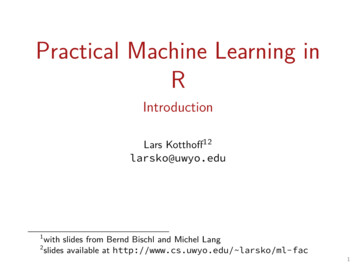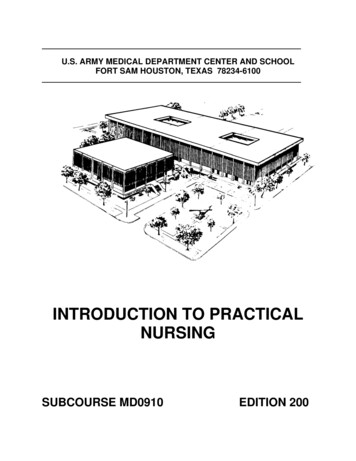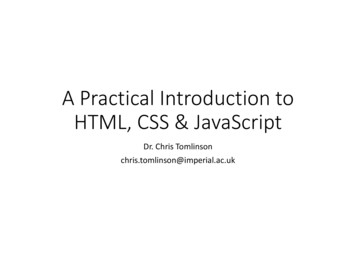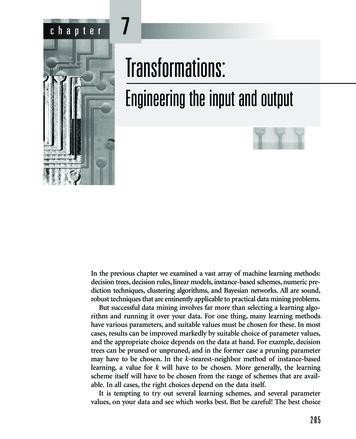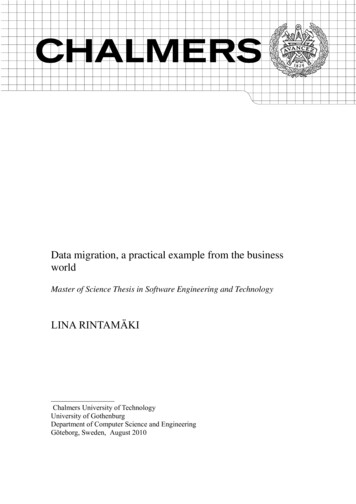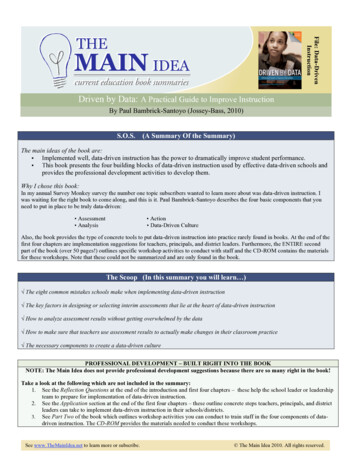
Transcription
A Practical Introduction toData Structures and AlgorithmAnalysisThird Edition (Java)Clifford A. ShafferDepartment of Computer ScienceVirginia TechBlacksburg, VA 24061April 16, 2009Copyright c 2008 by Clifford A. Shaffer.This document is the draft of a book to be published by Prentice Halland may not be duplicated without the express written consentof either the author or a representative of the publisher.
ContentsPrefacexiiiIPreliminaries11Data Structures and Algorithms1.1 A Philosophy of Data Structures1.1.1 The Need for Data Structures1.1.2 Costs and Benefits1.2 Abstract Data Types and Data Structures1.3 Design Patterns1.3.1 Flyweight1.3.2 Visitor1.3.3 Composite1.3.4 Strategy1.4 Problems, Algorithms, and Programs1.5 Further Reading1.6 Exercises3446812131415161719212Mathematical Preliminaries2.1 Sets and Relations2.2 Miscellaneous Notation2.3 Logarithms2.4 Summations and Recurrences2525293133iii
ivContents2.52.62.72.82.93II4RecursionMathematical Proof Techniques2.6.1 Direct Proof2.6.2 Proof by Contradiction2.6.3 Proof by Mathematical InductionEstimatingFurther ReadingExercisesAlgorithm Analysis3.1 Introduction3.2 Best, Worst, and Average Cases3.3 A Faster Computer, or a Faster Algorithm?3.4 Asymptotic Analysis3.4.1 Upper Bounds3.4.2 Lower Bounds3.4.3 Θ Notation3.4.4 Simplifying Rules3.4.5 Classifying Functions3.5 Calculating the Running Time for a Program3.6 Analyzing Problems3.7 Common Misunderstandings3.8 Multiple Parameters3.9 Space Bounds3.10 Speeding Up Your Programs3.11 Empirical Analysis3.12 Further Reading3.13 Exercises3.14 ProjectsFundamental Data StructuresLists, Stacks, and 8486899091959799
vContents4.14.24.34.44.54.64.75Lists4.1.1 Array-Based List Implementation4.1.2 Linked Lists4.1.3 Comparison of List Implementations4.1.4 Element Implementations4.1.5 Doubly Linked ListsStacks4.2.1 Array-Based Stacks4.2.2 Linked Stacks4.2.3 Comparison of Array-Based and Linked Stacks4.2.4 Implementing RecursionQueues4.3.1 Array-Based Queues4.3.2 Linked Queues4.3.3 Comparison of Array-Based and Linked QueuesDictionaries and ComparatorsFurther ReadingExercisesProjectsBinary Trees5.1 Definitions and Properties5.1.1 The Full Binary Tree Theorem5.1.2 A Binary Tree Node ADT5.2 Binary Tree Traversals5.3 Binary Tree Node Implementations5.3.1 Pointer-Based Node Implementations5.3.2 Space Requirements5.3.3 Array Implementation for Complete Binary Trees5.4 Binary Search Trees5.5 Heaps and Priority Queues5.6 Huffman Coding Trees5.6.1 Building Huffman Coding 9
viContents5.75.85.96III75.6.2 Assigning and Using Huffman CodesFurther ReadingExercisesProjectsNon-Binary Trees6.1 General Tree Definitions and Terminology6.1.1 An ADT for General Tree Nodes6.1.2 General Tree Traversals6.2 The Parent Pointer Implementation6.3 General Tree Implementations6.3.1 List of Children6.3.2 The Left-Child/Right-Sibling Implementation6.3.3 Dynamic Node Implementations6.3.4 Dynamic “Left-Child/Right-Sibling” Implementation6.4 K-ary Trees6.5 Sequential Tree Implementations6.6 Further Reading6.7 Exercises6.8 ProjectsSorting and SearchingInternal Sorting7.1 Sorting Terminology and Notation7.2 Three Θ(n2 ) Sorting Algorithms7.2.1 Insertion Sort7.2.2 Bubble Sort7.2.3 Selection Sort7.2.4 The Cost of Exchange Sorting7.3 Shellsort7.4 Mergesort7.5 0221223226226230233235236237238240241243244246249
viiContents7.67.77.87.97.107.117.12HeapsortBinsort and Radix SortAn Empirical Comparison of Sorting AlgorithmsLower Bounds for SortingFurther ReadingExercisesProjects2562592652672712722758File Processing and External Sorting8.1 Primary versus Secondary Storage8.2 Disk Drives8.2.1 Disk Drive Architecture8.2.2 Disk Access Costs8.3 Buffers and Buffer Pools8.4 The Programmer’s View of Files8.5 External Sorting8.5.1 Simple Approaches to External Sorting8.5.2 Replacement Selection8.5.3 Multiway Merging8.6 Further Reading8.7 Exercises8.8 9Searching9.1 Searching Unsorted and Sorted Arrays9.2 Self-Organizing Lists9.3 Bit Vectors for Representing Sets9.4 Hashing9.4.1 Hash Functions9.4.2 Open Hashing9.4.3 Closed Hashing9.4.4 Analysis of Closed Hashing9.4.5 Deletion317318324329330331336337346350
viiiContents9.59.69.7Further ReadingExercisesProjects35135235510 Indexing10.1 Linear Indexing10.2 ISAM10.3 Tree-based Indexing10.4 2-3 Trees10.5 B-Trees10.5.1 B -Trees10.5.2 B-Tree Analysis10.6 Further Reading10.7 Exercises10.8 nced Data Structures11 Graphs11.1 Terminology and Representations11.2 Graph Implementations11.3 Graph Traversals11.3.1 Depth-First Search11.3.2 Breadth-First Search11.3.3 Topological Sort11.4 Shortest-Paths Problems11.4.1 Single-Source Shortest Paths11.5 Minimum-Cost Spanning Trees11.5.1 Prim’s Algorithm11.5.2 Kruskal’s Algorithm11.6 Further Reading11.7 Exercises11.8 420
Contentsix12 Lists and Arrays Revisited12.1 Multilists12.2 Matrix Representations12.3 Memory Management12.3.1 Dynamic Storage Allocation12.3.2 Failure Policies and Garbage Collection12.4 Further Reading12.5 Exercises12.6 Projects42342342743043143844344444513 Advanced Tree Structures13.1 Tries13.2 Balanced Trees13.2.1 The AVL Tree13.2.2 The Splay Tree13.3 Spatial Data Structures13.3.1 The K-D Tree13.3.2 The PR quadtree13.3.3 Other Point Data Structures13.3.4 Other Spatial Data Structures13.4 Further Reading13.5 Exercises13.6 9Theory of Algorithms14 Analysis Techniques14.1 Summation Techniques14.2 Recurrence Relations14.2.1 Estimating Upper and Lower Bounds14.2.2 Expanding Recurrences14.2.3 Divide and Conquer Recurrences14.2.4 Average-Case Analysis of Quicksort481482487487491492495
xContents14.314.414.514.6Amortized AnalysisFurther ReadingExercisesProjects49649950050415 Lower Bounds15.1 Introduction to Lower Bounds Proofs15.2 Lower Bounds on Searching Lists15.2.1 Searching in Unsorted Lists15.2.2 Searching in Sorted Lists15.3 Finding the Maximum Value15.4 Adversarial Lower Bounds Proofs15.5 State Space Lower Bounds Proofs15.6 Finding the ith Best Element15.7 Optimal Sorting15.8 Further Reading15.9 2252452552716 Patterns of Algorithms16.1 Greedy Algorithms16.2 Dynamic Programming16.2.1 Knapsack Problem16.2.2 All-Pairs Shortest Paths16.3 Randomized Algorithms16.3.1 Skip Lists16.4 Numerical Algorithms16.4.1 Exponentiation16.4.2 Largest Common Factor16.4.3 Matrix Multiplication16.4.4 Random Numbers16.4.5 Fast Fourier Transform16.5 Further Reading529529530531532534536541542543543546546551
Contents16.6 Exercises16.7 Projectsxi55155217 Limits to Computation17.1 Reductions17.2 Hard Problems17.2.1 The Theory of N P-Completeness17.2.2 N P-Completeness Proofs17.2.3 Coping with N P-Complete Problems17.3 Impossible Problems17.3.1 Uncountability17.3.2 The Halting Problem Is Unsolvable17.4 Further Reading17.5 Exercises17.6 graphy585Index591
PrefaceWe study data structures so that we can learn to write more efficient programs. Butwhy must programs be efficient when new computers are faster every year? Thereason is that our ambitions grow with our capabilities. Instead of rendering efficiency needs obsolete, the modern revolution in computing power and storage capability merely raises the efficiency stakes as we computerize more complex tasks.The quest for program efficiency need not and should not conflict with sounddesign and clear coding. Creating efficient programs has little to do with “programming tricks” but rather is based on good organization of information and good algorithms. A programmer who has not mastered the basic principles of clear designis not likely to write efficient programs. Conversely, “software engineering” cannotbe used as an excuse to justify inefficient performance. Generality in design canand should be achieved without sacrificing performance, but this can only be doneif the designer understands how to measure performance and does so as an integralpart of the design and implementation process. Most computer science curricularecognize that good programming skills begin with a strong emphasis on fundamental software engineering principles. Then, once a programmer has learned theprinciples of clear program design and implementation, the next step is to study theeffects of data organization and algorithms on program efficiency.Approach: This book describes many techniques for representing data. Thesetechniques are presented within the context of the following principles:1. Each data structure and each algorithm has costs and benefits. Practitionersneed a thorough understanding of how to assess costs and benefits to be ableto adapt to new design challenges. This requires an understanding of theprinciples of algorithm analysis, and also an appreciation for the significanteffects of the physical medium employed (e.g., data stored on disk versusmain memory).xiii
xivPreface2. Related to costs and benefits is the notion of tradeoffs. For example, it is quitecommon to reduce time requirements at the expense of an increase in spacerequirements, or vice versa. Programmers face tradeoff issues regularly in allphases of software design and implementation, so the concept must becomedeeply ingrained.3. Programmers should know enough about common practice to avoid reinventing the wheel. Thus, programmers need to learn the commonly useddata structures, their related algorithms, and the most frequently encountereddesign patterns found in programming.4. Data structures follow needs. Programmers must learn to assess applicationneeds first, then find a data structure with matching capabilities. To do thisrequires competence in principles 1, 2, and 3.As I have taught data structures through the years, I have found that designissues have played an ever greater role in my courses. This can be traced throughthe various editions of this textbook by the increasing coverage for design patternsand generic interfaces. The first edition had no mention of design patterns. Thesecond edition had limited coverage of a few example patterns, and introducedthe dictionary ADT and comparator classes. With the third edition, there is explicitcoverage of some design patterns that are encountered when programming the basicdata structures and algorithms covered in the book.Using the Book in Class: Data structures and algorithms textbooks tend to fallinto one of two categories: teaching texts or encyclopedias. Books that attempt todo both usually fail at both. This book is intended as a teaching text. I believe it ismore important for a practitioner to understand the principles required to select ordesign the data structure that will best solve some problem than it is to memorize alot of textbook implementations. Hence, I have designed this as a teaching text thatcovers most standard data structures, but not all. A few data structures that are notwidely adopted are included to illustrate important principles. Some relatively newdata structures that should become widely used in the future are included.Within an undergraduate program, this textbook is designed for use in either anadvanced lower division (sophomore or junior level) data structures course, or fora senior level algorithms course. New material has been added in the third editionto support its use in an algorithms course. Normally, this text would be used in acourse beyond the standard freshman level “CS2” course that often serves as the initial introduction to data structures. Readers of this book should have programmingexperience, typically two semesters or the equivalent of a structured programminglanguage such as Pascal or C, and including at least some exposure to Java. Readers who are already familiar with recursion will have an advantage. Students of
Prefacexvdata structures will also benefit from having first completed a good course in Discrete Mathematics. Nonetheless, Chapter 2 attempts to give a reasonably completesurvey of the prerequisite mathematical topics at the level necessary to understandtheir use in this book. Readers may wish to refer back to the appropriate sectionsas needed when encountering unfamiliar mathematical material.A sophomore-level class where students have only a little background in basicdata structures or analysis (that is, background equivalent to what would be hadfrom a traditional CS2 course) might cover Chapters 1-11 in detail, as well as selected topics from Chapter 13. That is how I use the book for my own sophomorelevel class. Students with greater background might cover Chapter 1, skip mostof Chapter 2 except for reference, briefly cover Chapters 3 and 4, and then coverchapters 5-12 in detail. Again, only certain topics from Chapter 13 might be covered, depending on the programming assignments selected by the instructor. Asenior-level algorithms course would focus on Chapters 11 and 14-17.Chapter 13 is intended in part as a source for larger programming exercises.I recommend that all students taking a data structures course be required to implement some advanced tree structure, or another dynamic structure of comparabledifficulty such as the skip list or sparse matrix representations of Chapter 12. Noneof these data structures are significantly more difficult to implement than the binarysearch tree, and any of them should be within a student’s ability after completingChapter 5.While I have attempted to arrange the presentation in an order that makes sense,instructors should feel free to rearrange the topics as they see fit. The book has beenwritten so that once the reader has mastered Chapters 1-6, the remaining materialhas relatively few dependencies. Clearly, external sorting depends on understanding internal sorting and disk files. Section 6.2 on the UNION/FIND algorithm isused in Kruskal’s Minimum-Cost Spanning Tree algorithm. Section 9.2 on selforganizing lists mentions the buffer replacement schemes covered in Section 8.3.Chapter 14 draws on examples from throughout the book. Section 17.2 relies onknowledge of graphs. Otherwise, most topics depend only on material presentedearlier within the same chapter.Most chapters end with a section entitled “Further Reading.” These sectionsare not comprehensive lists of references on the topics presented. Rather, I includebooks and articles that, in my opinion, may prove exceptionally informative orentertaining to the reader. In some cases I include references to works that shouldbecome familiar to any well-rounded computer scientist.Use of Java: The programming examples are written in JavaTM . As with anyprogramming language, Java has both advantages and disadvantages. Java is a
xviPrefacesmall language. There usually is only one way to do something, and this has thehappy tendency of encouraging a programmer toward clarity when used correctly.In this respect, it is superior to C or C . Java serves nicely for defining andusing most traditional data structures such as lists and trees. On the other hand,Java is quite poor when used to do file processing, being both cumbersome andinefficient. It is also a poor language when fine control of memory is required. Asan example, applications requiring memory management, such as those discussedin Section 12.3, are difficult to write in Java. Since I wish to stick to a singlelanguage throughout the text, like any programmer I must take the bad along withthe good. The most important issue is to get the ideas across, whether or not thoseideas are natural to a particular language of discourse. Most programmers willuse a variety of programming languages throughout their career, and the conceptsdescribed in this book should prove useful in a variety of circumstances.I do not wish to discourage those unfamiliar with Java from reading this book.I have attempted to make the examples as clear as possible while maintaining theadvantages of Java. Java is used here strictly as a tool to illustrate data structuresconcepts. Fortunately, Java is an easy language for C or Pascal programmers to readwith a minimal amount of study of the syntax related to object-oriented programming. In particular, I make use of Java’s support for hiding implementation details,including features such as classes, private class members, and interfaces. Thesefeatures of the language support the crucial concept of separating logical design, asembodied in the abstract data type, from physical implementation as embodied inthe data structure.I make no attempt to teach Java within the text. An Appendix is providedthat describes the Java syntax and concepts necessary to understand the programexamples. I also provide the actual Java code used in the text through anonymousFTP.Inheritance, a key feature of object-oriented programming, is used only sparingly in the code examples. Inheritance is an important tool that helps programmersavoid duplication, and thus minimize bugs. From a pedagogical standpoint, however, inheritance often makes code examples harder to understand since it tends tospread the description for one logical unit among several classes. Thus, some ofmy class definitions for objects such as tree or list nodes do not take full advantageof possible inheritance from earlier code examples. This does not mean that a programmer should do likewise. Avoiding code duplication and minimizing errors areimportant goals. Treat the programming examples as illustrations of data structureprinciples, but do not copy them directly into your own programs.
PrefacexviiMy Java implementations serve to provide concrete illustrations of data structure principles. They are not meant to be a series of commercial-quality Javaclass implementations. The code examples provide less parameter checking thanis sound programming practice for commercial programmers. Some parameterchecking is included in the form of calls to methods in class Assert. Thesemethods are modeled after the C standard library function assert. MethodAssert.notFalse takes a Boolean expression. If this expression evaluates tofalse, then the program terminates immediately. Method Assert.notNulltakes a reference to class Object, and terminates the program if the value of thereference is null. (To be precise, these functions throw an IllegalArgumentException, which typically results in terminating the program unless the programmer takes action to handle the exception.) Terminating a program when afunction receives a bad parameter is generally considered undesirable in real programs, but is quite adequate for understanding how a data structure is meant to operate. In real programming applications, Java’s exception handling features shouldbe used to deal with input data errors.I make a distinction in the text between “Java implementations” and “pseudocode.” Code labeled as a Java implementation has actually been compiled andtested on one or more Java compilers. Pseudocode examples often conform closelyto Java syntax, but typically contain one or more lines of higher level description.Pseudocode is used where I perceived a greater pedagogical advantage to a simpler,but less precise, description.Exercises and Projects: Proper implementation and anaysis of data structurescannot be learned simply by reading a book. You must practice by implementingreal programs, constantly comparing different techniques to see what really worksbest in a given situation.One of the most important aspects of a course in data structures is that it iswhere students really learn to program using pointers and dynamic memory allocation, by implementing data structures such as linked lists and trees. Its also wherestudents truly learn recursion. In our curriculum, this is the first course wherestudents do significant design, because it often requires real data structures to motivate significant design exercises. Finally, the fundamental differences betweenmemory-based and disk-based data access cannot be appreciated without practicalprogramming experience. For all of these reasons, a data structures course cannotsucceed without a significant programming component. In our department, the datastructures course is arguably the most difficult programming course in the curriculum.
xviiiPrefaceStudents should also work problems to develop their analytical abilities. I provide over 400 exercises and suggestions for programming projects. I urge readersto take advantage of them.Contacting the Author and Supplementary Materials: A book such as thisis sure to contain errors and have room for improvement. I welcome bug reportsand constructive criticism. I can be reached by electronic mail via the Internet atshaffer@vt.edu. Alternatively, comments can be mailed toCliff ShafferDepartment of Computer ScienceVirginia TechBlacksburg, VA 24061A set of transparency masters for use in conjunction with this book can be obtained via the WWW at http://www.cs.vt.edu/ shaffer/book.html.The Java code examples are also available this site. Online Web pages for VirginiaTech’s sophomore-level data structures class can be found at URLhttp://courses.cs.vt.edu/ cs3114This book was originally typeset by the author with LATEX. The bibliographywas prepared using BIBTEX. The index was prepared using makeindex. Thefigures were mostly drawn with Xfig. Figures 3.1 and 9.8 were partially createdusing Mathematica.Acknowledgments: It takes a lot of help from a lot of people to make a book.I wish to acknowledge a few of those who helped to make this book possible. Iapologize for the inevitable omissions.Virginia Tech helped make this whole thing possible through sabbatical research leave during Fall 1994, enabling me to get the project off the ground. My department heads during the time I have written the various editions of this book, Dennis Kafura and Jack Carroll, provided unwavering moral support for this project.Mike Keenan, Lenny Heath, and Jeff Shaffer provided valuable input on early versions of the chapters. I also wish to thank Lenny Heath for many years of stimulating discussions about algorithms and analysis (and how to teach both to students).Steve Edwards deserves special thanks for spending so much time helping me onvarious redesigns of the C and Java code versions for the second and third editions, and many hours of discussion on the principles of program design. Thanksto Layne Watson for his help with Mathematica, and to Bo Begole, Philip Isenhour,Jeff Nielsen, and Craig Struble for much technical assistance. Thanks to Bill McQuain, Mark Abrams and Dennis Kafura for answering lots of silly questions aboutC and Java.
PrefacexixI am truly indebted to the many reviewers of the various editions of this manuscript. For the first edition these reviewers included J. David Bezek (University ofEvansville), Douglas Campbell (Brigham Young University), Karen Davis (University of Cincinnati), Vijay Kumar Garg (University of Texas – Austin), Jim Miller(University of Kansas), Bruce Maxim (University of Michigan – Dearborn), JeffParker (Agile Networks/Harvard), Dana Richards (George Mason University), JackTan (University of Houston), and Lixin Tao (Concordia University). Without theirhelp, this book would contain many more technical errors and many fewer insights.For the second edition, I wish to thank these reviewers: Gurdip Singh (KansasState University), Peter Allen (Columbia University), Robin Hill (University ofWyoming), Norman Jacobson (University of California – Irvine), Ben Keller (Eastern Michigan University), and Ken Bosworth (Idaho State University). In addition,I wish to thank Neil Stewart and Frank J. Thesen for their comments and ideas forimprovement.Third edition reviewers included Randall Lechlitner (University of Houstin,Clear Lake) and Brian C. Hipp (York Technical College). I thank them for theircomments.Without the hard work of many people at Prentice Hall, none of this would bepossible. Authors simply do not create printer-ready books on their own. Foremostthanks go to Kate Hargett, Petra Rector, Laura Steele, and Alan Apt, my editorsover the years. My production editors, Irwin Zucker for the second edition, Kathleen Caren for the original C version, and Ed DeFelippis for the Java version,kept everything moving smoothly during that horrible rush at the end. Thanks toBill Zobrist and Bruce Gregory (I think) for getting me into this in the first place.Others at Prentice Hall who helped me along the way include Truly Donovan, LindaBehrens, and Phyllis Bregman. I am sure I owe thanks to many others at PrenticeHall for their help in ways that I am not even aware of.I wish to express my appreciation to Hanan Samet for teaching me about datastructures. I learned much of the philosophy presented here from him as well,though he is not responsible for any problems with the result. Thanks to my wifeTerry, for her love and support, and to my daughters Irena and Kate for pleasantdiversions from working too hard. Finally, and most importantly, to all of the datastructures students over the years who have taught me what is important and whatshould be skipped in a data structures course, and the many new insights they haveprovided. This book is dedicated to them.Clifford A. ShafferBlacksburg, Virginia
PART IPreliminaries1
1Data Structures and AlgorithmsHow many cities with more than 250,000 people lie within 500 miles of Dallas,Texas? How many people in my company make over 100,000 per year? Can weconnect all of our telephone customers with less than 1,000 miles of cable? Toanswer questions like these, it is not enough to have the necessary information. Wemust organize that information in a way that allows us to find the answers in timeto satisfy our needs.Representing information is fundamental to computer science. The primarypurpose of most computer programs is not to perform calculations, but to store andretrieve information — usually as fast as possible. For this reason, the study ofdata structures and the algorithms that manipulate them is at the heart of computerscience. And that is what this book is about — helping you to understand how tostructure information to support efficient processing.This book has three primary goals. The first is to present the commonly useddata structures. These form a programmer’s basic data structure “toolkit.” Formany problems, some data structure in the toolkit provides a good solution.The second goal is to introduce the idea of tradeoffs and reinforce the conceptthat there are costs and benefits associated with every data structure. This is doneby describing, for each data structure, the amount of space and time required fortypical operations.The third goal is to teach how to measure the effectiveness of a data structure oralgorithm. Only through such measurement can you determine which data structurein your toolkit is most appropriate for a new problem. The techniques presentedalso allow you to judge the merits of new data structures that you or others mightinvent.There are often many approaches to solving a problem. How do we choosebetween them? At the heart of computer program design are two (sometimes conflicting) goals:3
4Chap. 1 Data Structures and Algorithms1. To design an algorithm that is easy to understand, code, and debug.2. To design an algorithm that makes efficient use of the computer’s resources.Ideally, the resulting program is true to both of these goals. We might say thatsuch a program is “elegant.” While the algorithms and program code examples presented here attempt to be elegant in this sense, it is not the purpose of this book toexplicitly treat issues related to goal (1). These are primarily concerns of the discipline of Software Engineering. Rather, this book is mostly about issues relating togoal (2).How do we measure efficiency? Chapter 3 describes a method for evaluatingthe efficiency of an algorithm or computer program, called asymptotic analysis.Asymptotic analysis also allows you to measure the inherent difficulty of a problem.The remaining chapters use asymptotic analysis techniques for every algorithmpresented. This allows you to see how each algorithm compares to other algorithmsfor solving the same problem in terms of its efficiency.This first chapter sets the stage for what is to follow, by presenting some higherorder issues related to the selection and use of data structures. We first examine theprocess by which a designer selects a data structure appropriate to the task at hand.We then consider the role of abstraction in program design. We briefly considerthe concept of a design pattern and see some examples. The chapter ends with anexploration of the relationship between problems, algorithms, and programs.1.1A Philosophy of Data Structures1.1.1The Need for Data StructuresYou might think that with ever more powerful computers, program efficiency isbecoming less important. After all, processor speed and memory size still seem todouble every couple of years. Won’t any efficiency problem we might have todaybe solved by tomorrow’s hardware?As we develop more powerful computers, our history so far has always beento use additional computing power to tackle more complex problems, be it in theform of more sophisticated user interfaces, bigger problem sizes, or new problemspreviously deemed computationally infeasible. More complex problems demandmore computation, making the need for efficient programs even greater. Worse yet,as tasks become more complex, they become less like our everyday experience.Today’s computer scientists must be trained to have a thorough understanding of theprinciples behind efficient program design, because their ordinary life experiencesoften do not apply when designing computer programs.
Sec. 1.1 A Philosophy of Data Structu
Apr 16, 2009 · Approach: This book describes many techniques for representing data. These techniques are presented within the context of the following principles: 1. Each data structure and each algorithm has costs and benefits. Practitioners need a thorough understanding of how to assess costs



